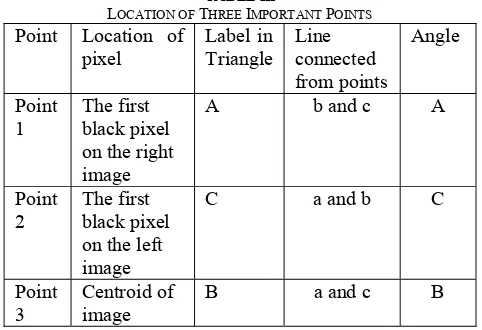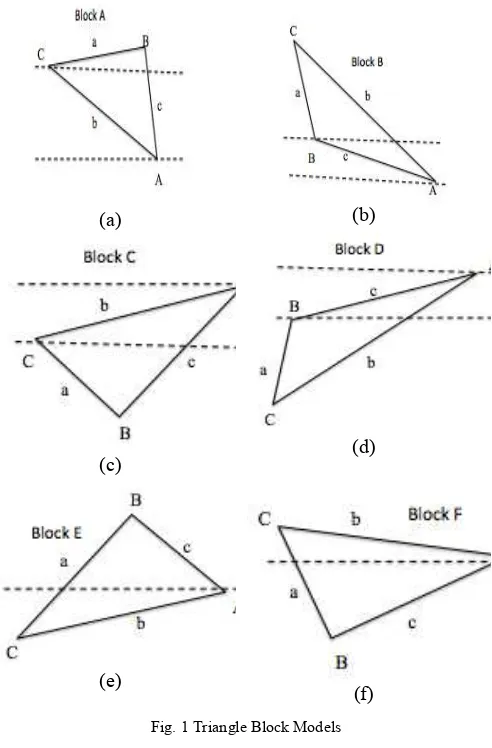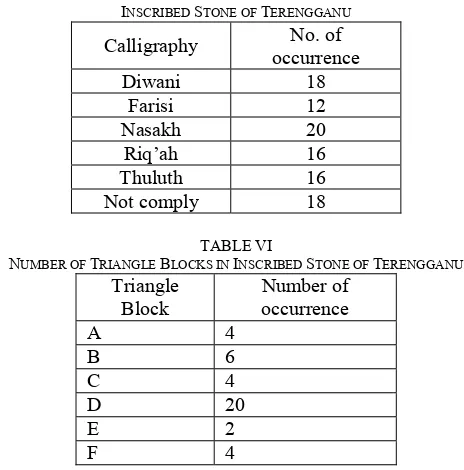2011 International Conference on Electrical Engineering and Informatics
17-19 July 2011, Bandung, Indonesia
Arabic Calligraphy Identification for Digital Jawi
Paleography using Triangle Blocks
Mohd Sanusi Azmi
#1, Khairuddin Omar
*2, Mohammad Faidzul Nasrudin
*3Khadijah Wan Mohd Ghazali
#4, Azizi
Abdullah
*51,4
Faculty of Information Communication and Technology Universiti Teknikal Malaysia Melaka, Malaysia
1
2,3,5
Faculty of Information Science and Technology Universiti Kebangsaan Malaysia, Bangi, Malaysia
2
5
Abstract—Digital Jawi Paleography is a field of research that helps paleographers to identify authors, origin and date of Jawi manuscripts. This research is important because of the existence of a huge amount of Malay manuscripts with unidentified authors, origin and date. Most researches in the area are for Roman and Hebrew text, whereas researches for Jawi text have just begun recently. In this paper, a novel technique is proposed in order to identify types of Arabic calligraphy in Malay ancient manuscripts that were written in Jawi. The novel technique is based on the triangle blocks that were adapted from scalene triangle. Twenty-one features have been extracted from the triangle blocks.
Keywords— Paleography, Jawi, Features Extraction
I. INTRODUCTION
Malay ancient manuscripts portray a lot of information implicitly or explicitly. This is proved by [1]. The work identified three unknown authors who wrote the book “Kitab Undang-Undang Melayu” in the middle of 18th century by identifying the type of calligraphy applied in the ancient book. This is also supported by [2]. From the research conducted in [3], four types of arabic calligraphy were found in “Hikayat Merong Mahawangsa”. Calligraphy type identification applied to the manuscripts is a subset of paleography study. Research done in [4] for Roman ancient manuscripts and [5] for Hebrew ancient manuscripts used type of calligraphy in order to identify the origin and dating of manuscripts. The researches fall under digital paleography researches [4-6]. The purpose of the research is to assist paleographers in order to identify the origin and dating of manuscripts [3-5]. The first digital paleography was developed in University of Pisa, Italy
paleography for Hebrew styles of writing in order to identify the origin and dating was conducted [5]. Two years later, [4] introduced the global approach in order to identify the style of calligraphy applied in the Roman ancient manuscripts. On the other hand, digital Jawi paleography is still at an early stage. The first Digital Jawi Paleography framework has been introduced in [6].
The motivation for Digital Jawi Paleography research is the huge number of Malay manuscripts that exists. In Malaysia alone the number is around 7789 and many others are located outside Malaysia such as in British Library, UK and Leiden University, Holland [6,9].
In order to do research in Digital Jawi Paleography, research conducted by [4,5,7] has been studied. In [7], statistical approach was used. Centroid and tangent values were used to cluster Roman alphabets collected from 37 manuscript books into Dendogram diagrams. Due to the lack of features in [7], [4] introduced global approach by using twelve Haralick’s features. The haralick’s features are also known as Grey-Level Co-occurrence Matrix (GLCM). For Hebrew digital paleography, [5] used local features from only five selected Hebrew alphabets. For feature extractions and testing, only two alphabets were chosen. No justification is stated on the selection of the few alphabets. [5] introduced a technique that is based on the space from selected alphabets. The test conducted in [5] is also insufficient because only 14 documents were chosen with only twenty Aleph and Lamed chosen from each document.
Model. The relationship between triangular blocks with Arabic calligraphy and is written in [10]
II. PRE-PROCESSING
We suggest a new technique that is based on the Scalene Triangle. The processes that take place in our proposed algorithms are:
i. Data Collection,
ii. Pre-processing,
iii. Features extraction and Proposed method iv. Testing
The Features Extraction and Proposed method will be detailed here because it is a novel technique for Digital Jawi Paleography that is currently researched in Faculty of Information Science and Technology, Universiti Kebangsaan Malaysia, Bangi.
A. Data collection
The data collected are from Malay ancients manuscripts and an inscribed stone. The manuscripts that were chosen are Hikayat Merong Mahawangsa and unknown manuscripts from National Library of Malaysia. The inscribed stone that was chosen is the inscribed stone of Terengganu. The examples of data that were used are in Table 1 below.
TABLEI
SAMPLE MALAY ANCIENT MANUSCRIPTS
The Inscribed Stone of Terengganu
Hikayat Merong Mahawangsa- page1
Hikayat Merong Mahawangsa- page30
B. Pre-processing
Images from the stated Malay ancients manuscripts and inscribed stone are manually segmented into twenty alphabets in random representation. The segmented Jawi alphabets are in initial, middle, end or isolated state. This manual segmentation is done based on [5].
A default threshold value of 127 was given to the segmented alphabets/images except for some images with lower quality that required a threshold value of 180. The process converted RGB to binary color model as shown in Table 2.
TABLEII THRESHOLD PROCESS
Original Image Threshold value
127
Threshold value 180
After segmentation process was done, images were cleaned from noise pixels. As the quality of ancient manuscripts and inscribed stone normally get degraded with time, the images can be unclear and smeared [5,11]. After this process, the images are ready for features extraction process.
C. Features extraction and proposed method
The features extraction in this research is using Triangular Block Model that is adapted from Scalene Triangle. The processes are divided into three sub processes.
• Selection of three important points.
• Formation of type of blocks.
• Features Extraction based on Scalene Triangle.
21 features are extracted from Scalene Triangle including the type of blocks. These features will be used in order to identify the Arabic calligraphy that was applied in the manuscripts and inscribed stone. The details are discussed in the Proposed Method subtopic.
D. Testing.
Testing is conducted using forty segmented images of the Inscribed Stone of Terengganu, twenty images from the first
page of Hikayat Merong Mahawangsa, twenty images from
page 1 and 30. The result from the test data will be compared
with result from standard calligraphies taken from
k-Jawi
software from Ministry Of Unity, Culture, Arts, Heritage and Tuan Haji Hamdan Abdul Rahman, the Malay language expert for the Dewan Bahasa dan Pustaka, Malaysia.
III.PROPOSEDMETHOD
A. Selection of three important points.
The three important points can be extracted from specific coordinates after images are freed from any unwanted noises. The three points selected are based on black pixels from the image. The selection of three points are chosen and labeled based on Table 3 below.
TABLEIII
LOCATION OF THREE IMPORTANT POINTS
Point Location of
pixel
TABLEIV COORDINATE OF THREE POINTS.
Triangle Image Point
Point 1 x : 21 y : 17 Point 2 x : 3 y : 27
Point 3 x : 13 y : 23
B. Formation of the type of Triangle Blocks
From research that has been conducted on three selected points, it is found that, if A is fixed to the right and C to the left whereas B is always in between A and C, it is possible that the triangle geometry models can be formed in six blocks. Fig. 1 below shows the possible triangle blocks.
(a) (b)
(c) (d)
(e)
(f)
Fig. 1 Triangle Block Models
The triangle types formed from Fig. 1 above are based on the y-coordinate for points A, B and C as shown in Table 5.
TABLEII POSITION OF COORDINATE Y
Shape Coordinate y
A B C D E F
C. Features Extraction
After the six triangle blocks are formed, the next process is features extraction from the triangle blocks that are based on the three selected points on the image. There are twenty-one features extracted including the proposed triangle block. Table 6 shows features extracted from triangle blocks that are proposed in Fig. 1.
TABLEIIII
FEATURES FROM SCALENE TRIANGLE
Number Feature Name Description
1 Triangle Blocks
Block A, B, C, D, E and F
2 a Length from B(x,y) to C(x,y)
3 b Length from A(x,y) to C(x,y)
4 c Length from A(x,y) to B(x,y)
5 Ratio c/a Ratio c to a
6 A Angle of A
7 B Angle of B
8 C Angle of C
9 Angle of A to
B
Magnitude of A
10 Area Area
11 Angle of
Bisector side a (ta)
12 Angle of
Bisector side b (tb)
13 Angle of
Bisector side c (tc)
14 Median of
side a
ma
15 Median of
side b
mb
16 Median of
side c
mc
17 Altitude of
side a
ha
18 Altitude of
side b
hb
19 Altitude of
side c
hc
20 Circumscribed R
21 Inscribed Circle Radius
r
IV.EXPERIMENTAL RESULT
In the testing phase, segmented images selected from the
inscribed stone and Malay ancient manuscripts will be
identified.
The segmented images will be tested with the proposed method that has been developed. Next, result generated from the proposed method will be evaluated with the existing result from five types of calligraphy that are taken from k-Jawi software from Ministry Of Unity, Culture, Arts, Heritage and Tuan Haji Hamdan Abdul Rahman the Malay language expert for the Dewan Bahasa dan Pustaka, Malaysia.
Table 7 shows the result of the number of occurrences of every type of Arabic calligraphy in the inscribed stone of Terengganu. From forty segmented images that were tested, eighteen of them do not comply with standard Arabic calligraphy and the rest show that Arabic calligraphies exist in the inscribed stone. Block D is the highest occurrence in the inscribed stone, based on the result in Table 8.
TABLEIVI
NUMBER OF ARABIC CALLIGRAPHY IN FORTY SEGMENTED IMAGES IN THE
INSCRIBED STONE OF TERENGGANU
Table 9 and 10 below show result from the tests conducted to the two ancient Malay manuscripts. Twenty images each
were extracted from page of from Hikayat Merong
Mahawangsa on page 1 and 30.
Number of non-compliance from manuscript is lower compared to the inscribed stone.
TABLEIX
NUMBER OF ARABIC CALLIGRAPHY IN TESTED MALAY ANCIENT MANUSCRIPTS
NUMBER OF PROPOSED TRIANGLE BLOCKS IN TESTED MANUSCRIPTS
Triangle
In this paper, the topic under study is the triangle blocks. The blocks extracted from the features extraction will be compared with triangle blocks extracted from the dataset based on the K-Jawi software. For the time being, only seven out of the twenty-one features were used to form the triangle blocks. This is because the novel technique is currently still under research in Faculty of Information Science and Technology, Universiti Kebangsaan Malaysia. The next fourteen features including the current seven features will be used in the
classification process. Based on the triangle blocks, the
accuracy of type of Arabic calligraphy can only be determined by analysing extracted features by adapting scalene triangle. This research will be expanded by using the Perception Based Model that can exploit scalene triangle to be tested with Jawi ancient manuscript.
VI.ACKNOWLEDGMENT
REFERENCES
[1] M.J. Abd. Rahman, Teks undang-undang melayu pertengahan abad kelapan belas, Kuala Lumpur: Dewan Bahasa dan Pustaka, 1994. [2] M.S. Azmi, K. Omar, and A. Abdullah, “Perekayasaan Histogram
Orientasi Kecerunan Mengesan Erotan dan Pencongan manuskript Merong Mahawangsa,” Jurnal Teknologi Maklumat & Multimedia, vol. 2, 2005, pp. 63-79.
[3] K. Omar, M.S. Azmi, S.N. Syeikh Abdullah, A. Abdullah, and M.F. Nasrudin, “Framework of Jawi Digital Paleography: A Preliminar Work,” 2nd International Conference on Mathematical Sciences, Kuala Lumpur: Universit Kebangsaan Malaysia, 2010, p. 5. [4] I. Moalla, a M. Alimi, F. Lebourgeois, and H. Emptoz, “Image
Analysis for Palaeography Inspection,” Second International Conference on Document Image Analysis for Libraries (DIAL 06), 2006, pp. 303-311.
[5] I.B. Yosef, K. Kedem, I. Dinstein, M. Beit-arie, and E. Engel, “Classification of Hebrew Calligraphic Handwriting Styles : Preliminary Results,” Analysis, 2004.
[6] K. Omar, M.S. Azmi, S.N. Syeikh Abdullah, M.F. Nasrudin, and A. Abdullah, “Kerangka Paleografi Jawi Digital : Satu Cadangan Awal,” Seminar, 2010, pp. 1-14.
[7] and G.Z. Aiolli, F., M. Simi, D. Sona, A. Sperduti, A. Starita, “SPI: A System for Palaeographic Inspection,” vol. 4, 1999, pp. 34-38. [8] A. Ciula, “Digital palaeography : using the digital representation of
medieval script to support palaeographic analysis,” vol. 1, 2005, pp. 1-31.
[9] M.H. Rifin and A.N. Zainab, “Creating a Digital Library to Handle Malay Manuscripts Using Greenstone,” Image (Rochester, N.Y.), 2007, pp. 223-231.
[10] K. Omar, M. Sanusi, and A. Razak, “Batu Bersurat Terenganu : Perspektif Geometri Segitiga,” Seminar Batu Bersurat Piagam Terengganu, Kuala Terengganu, Malaysia: Lembaga Muzium Negeri Terengganu, 2011.


